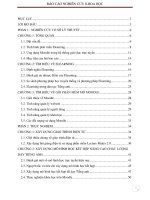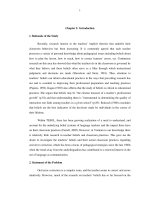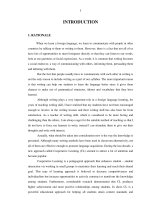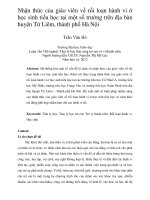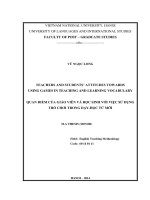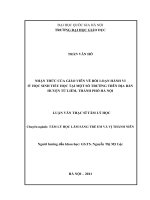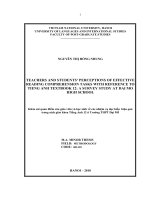Quan điểm của giáo viên về việc sử dụng phương pháp học hợp tác để dạy tiếng Anh tại các lớp Đông Đa trình độ và việc thực thi trên lớp tại trường Đại học Kinh
Bạn đang xem bản rút gọn của tài liệu. Xem và tải ngay bản đầy đủ của tài liệu tại đây (1.14 MB, 107 trang )
1
VIETNAM NATIONAL UNIVERSITY
UNIVERSITY OF LANGUAGES AND INTERNATIONAL STUDIES
FACULTY OF POST-GRADUATE STUDIES
---***--HOÀNG VIỆT HÀ
TEACHERS’ PERCEPTIONS & THEIR PRACTICES
REGARDING COOPERATIVE LEARNING IN TEACHING
EFL IN LARGE MULTILEVEL CLASSES AT VIETNAM
NATIONAL UNIVERSITY, UNIVERSITY OF ECONOMICS
AND BUSINESS
QUAN ĐIỂM CỦA GIÁO VIÊN VỀ VIỆC SỬ DỤNG PHƯƠNG
PHÁP HỌC HỢP TÁC ĐỂ DẠY TIẾNG ANH TẠI CÁC LỚP
ĐƠNG ĐA TRÌNH ĐỘ VÀ VIỆC THỰC THI TRÊN LỚP TẠI
TRƯỜNG ĐẠI HỌC KINH TẾ, ĐẠI HỌC QUỐC GIA HÀ NỘI
M.A. Thesis
Field: English Teaching Methodology
Code: 601410
Supervisor: Đỗ Bá Quý, M.Ed
2
VIETNAM NATIONAL UNIVERSITY, HANOI
UNIVERSITY OF LANGUAGES AND INTERNATIONAL STUDIES
FACULTY OF POST GRADUATE STUDIES
---***--HOÀNG VIỆT HÀ
TEACHERS’ PERCEPTIONS & THEIR PRACTICES
REGARDING COOPERATIVE LEARNING IN TEACHING
EFL IN LARGE MULTILEVEL CLASSES AT VIETNAM
NATIONAL UNIVERSITY, UNIVERSITY OF ECONOMICS
AND BUSINESS
QUAN ĐIỂM CỦA GIÁO VIÊN VỀ VIỆC SỬ DỤNG PHƯƠNG
PHÁP HỌC HỢP TÁC ĐỂ DẠY TIẾNG ANH TẠI CÁC LỚP
ĐƠNG ĐA TRÌNH ĐỘ VÀ VIỆC THỰC THI TRÊN LỚP TẠI
TRƯỜNG ĐẠI HỌC KINH TẾ, ĐẠI HỌC QUỐC GIA HÀ NỘI
M.A. Thesis
Field: English Teaching Methodology
Code: 601410
Hanoi, 2012
6
TABLE OF CONTENTS
PAGE
Acceptance page .........................................................................................................i
Acknowledgements .....................................................................................................ii
Abstract ........................................................................................................................iii
Table of content ..........................................................................................................iv
PART A: INTRODUCTION ......................................................................................1
1. Rationale .....................................................................................................................1
2. Aims of the study ........................................................................................................2
3. Research questions ......................................................................................................2
4. Scope of the study .......................................................................................................2
5. Significance of the study ............................................................................................3
6. Methods of the study ..................................................................................................3
7 An overview of the rest of the study ...........................................................................4
PART B: DEVELOPMENT ........................................................................................6
CHAPTER 1: LITERATURE REVIEW ...................................................................6
1.1 Cooperative learning .................................................................................................6
1.1.1 Underpinning theory of cooperative learning ...........................................6
1.1.2 Definition of cooperative learning ................................................................7
1.1.3 Principles of cooperative learning ............................................................8
1.1.4 Cooperative Learning Methods ............................................................................11
1.1.5 Benefits of cooperative learning ...............................................................14
1.1.6 Challenges of cooperative learning ...........................................................15
1.1.7 Empirical studies related to cooperative learning .....................................16
1.1.8 Research Findings: implementation of cooperative learning ...................19
1.2 Multilevel classes ....................................................................................................... 23
1.2.1 Definition of multilevel classes ..................................................................23
1.2.2 Challenges of multilevel classes ...............................................................24
1.2.3 Cooperative learning in language pedagogy in multilevel classes……… 25
CHAPTER 2: METHODOLOGY ..............................................................................28
2.1Study Aims ................................................................................................................28
2.2 Research questions
.............................................................................................28
7
2.3. Research Design ......................................................................................................28
2.4 The Research Context ...............................................................................................29
2.5 Participants................................................................................................................30
2.6 Data Collection Instruments .....................................................................................31
2.6.1 Interview ....................................................................................................31
2.6.2 Observation ................................................................................................33
2.7 Data Analysis ............................................................................................................34
2.7.1 Interview ....................................................................................................34
2.7.2 Observation ................................................................................................35
CHAPTER 3: RESULTS OF THE STUDY ...............................................................35
3.1 Teachers‟ perceptions in different aspects of cooperative learning .........................36
3.1.1 Implementation ..........................................................................................36
3.1.2 Task construction .......................................................................................41
3.1.3 Group composition .....................................................................................42
3.1.4 Student preparation ....................................................................................43
3.1.5 Assessment .................................................................................................44
3.1.6 Student motivation .......................................................................................... 45
3.1.7 Teachers‟ reflection on CL .............................................................................. 45
3.2 Teachers‟ implementation of Cooperative Learning in classroom ................................. 47
3.2.1 Implementation ............................................................................................... 47
3.2.2 Task construction ............................................................................................ 48
3.2.3 Group composition .......................................................................................... 49
3.2.4 Student preparation ......................................................................................... 51
3.2.5 Assessment ...................................................................................................... 51
3.2.6 Student motivation .......................................................................................... 52
CHAPTER 4 : DISCUSSION OF THE STUDY ............................................................. 54
4.1 Teachers‟ perceptions of different aspects of cooperative learning .............................. 54
4.1.1 Implementation ............................................................................................... 54
4.1.2 Task construction ............................................................................................ 57
4.1.3 Group composition.......................................................................................... 58
4.1.4 Student preparation ......................................................................................... 59
4.1.5 Assessment .................................................................................................... 59
8
4.1.6 Student motivation .......................................................................................... 60
4.1.7 Teachers‟ reflections on CL ............................................................................ 60
4.2. Teachers‟ implementation of cooperative learning in their classroom .......................... 61
4.2.1 Implementation ............................................................................................... 62
4.2.2 Task construction ............................................................................................ 62
4.2.3 Group composition.......................................................................................... 63
4.3.4 Student preparation ......................................................................................... 63
4.4.5 Assessment .................................................................................................... 64
4.1.6 Student motivation .......................................................................................... 64
4.3 To what extent did their classroom practices reflect their perceptions .......................... 65
PART C: CONCLUSION ................................................................................................. 69
1. Conclusion
................................................................................................. 69
2. Implications for the use of CL in ELT ........................................................................... 70
3. Limitations of the study ................................................................................................. 71
4. Suggestions for further research ....................................................................................... 72
REFERENCES ................................................................................................................... 73
9
APPENDICES
Appendix 1A: Contents of the course book New English File Pre-intermediate
Appendix 1B: The Common European Framework of Reference for Languages
Appendix 2A: Interview questions
Appendix 2B: One example of transcription of teacher‟s Interviews
10
LISTS OF TABLES AND ABBREVIATIONS
Table 1A: Differences between cooperative learning and group learning
Table 1B: CL -An overview of some most popular methods
Table 1C: Some differences between learners in heterogeneous classes
Table 2A: Background information about the participants
Table 2B: Phrases of thematic analysis
Table 3A: CL benefits for students
Table 3B: CL benefits for teacher
Table 3C: Difficulties in using CL in classroom
Table 3D: Criteria in choosing CL tasks
Table 3E: Strategies to form groups
Table 3F: CL skills taught for students
Table 3G: Types of group works‟ assessment
Table 3H: Ways to motivate students
Table 3I: The nature of tasks in classroom
Table 3J: The types of group forming in classroom
Table 3K: Types of group works‟ assessment in classroom
Table 3L: Ways to motivate students in classroom
List of abbreviations
CL: Cooperative learning
LMLC: Large multilevel classes
VNU, UEB: Vietnam National University, University of Economics and Business
VNU, ULIS: Vietnam National University, University of Languages and International Studies
M.A: Master of Arts
M.Ed: Master of Education
Dr: Doctor
PART A: INTRODUCTION
This initial part states the rationale for the study, the aims, the scope and methods
of the thesis. More importantly, the research questions are identified to work as clear
11
guidelines for the whole research. Lastly, this part concludes with an overview of the rest
of the thesis, serving as a compass to orientate the readers throughout the study.
1. Rationale
It is widely accepted that we are living in a technological-based society where
individuals are required to depend on each other and think with others if we want to obtain
success. The ability to work together cooperatively has become one of the skills which
enable people to survive in the global workforce (Foyle & Shafto,1995). In response,
educators have proposed significant changes in educational setting to create an
environment where students have the opportunities to work together to develop
cooperative skills. As the result, an effective teaching and learning in this global era should
be the one which can create a situation context in which students have opportunities to
work together, then produce new knowledge, is cooperative learning. In a very basic sense,
“CL is the instructional use of small groups so that students share the responsibility of
working together to maximize their own and each other‟s learning” (Johnson, Johnson &
Holubec,2002).
In the context of Viet Nam National University, University of Economics and
Business, English is being taught as a compulsory subject for non-major students. As far as
the situation of English language learning and teaching is concerned, students have
confronted a number of obstacles preventing them from achieving communicative
competence and cooperating with each other. Moreover, because of credit course program,
students can choose English class to learn by themselves. Hence, a class may include a
number of highly achieving students having spent years on English learning at secondary
schools, some of them may have attained pre-intermediate level, and another number of
real beginners. The dramatic difference in student language competence actually creates a
great deal of impediment to instructors and learners and constitutes an important part of
inefficiency of the ELT. Cooperative learning is certainly an appropriate instructional
strategy for large multilevel classes where the teacher and the more capable students can
create supportive conditions for less capable students through cooperative work.
Cooperative learning has been composed on two fundamental basis of language education
which is psychological characteristics of learners in language classes and instructional
theories of language acquisition.
12
Although there have been very few studies on CL in Vietnamese context, a review
of studies that were done in Asian countries found that CL promotes learning is equivocal
and, moreover, it is of little interest to Asian teachers. (Thanh-Pham, Gillies
&Renshaw,2009).However, no research was studied about Vietnamese‟ teachers‟
perceptions and classroom practices regarding CL in teaching English in large multilevel
classes.
From the above-mentioned reasons, this thesis on teachers‟ perceptions of
implementing CL meets the research demand of the context.
2. Aims of the study
Firstly, the research thesis is expected to investigate EFL teachers‟ perceptions of
different aspects of cooperative learning in their classroom at VNU, UEB. Secondly, it
aims to explore how the teachers implemented cooperative learning in their classroom.
Finally, it aims to explore how teachers‟ practices in their classroom reflect their
perceptions. In brief, these aims could be summarized into three research questions.
3. Research questions
The study was guided by three main research questions:
1. What were the EFL teachers‟ perceptions of different aspects of cooperative learning
in their classroom at VNU, UEB?
2. How did they implement cooperative learning in their classroom?
3. To what extent did their classroom practices reflect their perceptions?
4. Scope of the study
The study is restricted to the area of investigating the perceptions of six teachers at
VNU, UEB about different aspects of CL and exploring their actual classroom practices.
After that similarities and differences between their perceptions and practices were
discussed.
The samples of the study are also limited to six teachers at VNU, UEB and only
first year students from main stream classes in one semester of school year at Vietnam
National University, University of Economics and Business. In second term of school
year 2011-2012, the students were learning A2 English Program with course book New
English File, Pre-intermediate.
5. Significance of the study
13
As one of the trail-blazing studies on implementing CL in LMLC at VNU, UEB,
the thesis could be particularly useful for students, teachers, and researchers who develop
an interest in the topic.
Specifically, since the study looked into implementing CL in LMLC and some
suggestions for implementing CL effectively, students can gain more knowledge to use CL
for communicative purposes, learn social and inter-personal skills which are very
important for them in global world now.
As for the teachers, they would get useful information on different types of CL
methods, CL activities, as well as some ways to apply CL effectively in their classroom.
Besides, they would have more ideas of implementing CL in other countries. In addition,
the study also provides teachers with some helpful suggestions so that they could take their
own initiatives to effectively implement CL in their classroom situations.
Finally, with regard to the researchers, those who happen to develop the same
interest in this topic could certainly rely on this research to find reliable and useful
information for their related study.
6. Methods of the study
6.1 Data collection methods
The qualitative teachnique was employed to collect data relevant to the research.
During the process of data collection, the researcher employed two different instruments
interview, and classroom observation. To be more detailed, a semi-structured interview
was conducted with 6 teachers at VNU, UEB. The interview was constructed to enable
each teacher to elaborate on the eight open questions about teachers‟ perceptions of
different aspects of cooperative learning and barriers hindering cooperative learning
practices. In addition, classroom observation was also used to explore how teachers
implemented cooperative learning and answer the question “is there any gap between their
perceptions and their real teaching?” During observation, the researcher filmed the lessons.
Each lesson lasted approximately 50 minutes and observations were conducted during two
lessons-100 minutes for each class.
6.2 Data analysis methods
14
The researcher analysed qualitative data based on phrases of thematic analysis such
as familiarizing yourself with data, generating initial codes, searching for themes,
reviewing themes, defining and naming the themes and producing the report.
To be more detailed, for the interview, the researcher transcribed all of the
interview and open-minded questions into Vietnamese. The researcher coded each
document by sentence and paragraph and questions. The researcher first constructed the
initial list of the most general concepts that spatially the connection in the data related to
descriptive, lexical meaning or low level inference of text. Then the researcher investigated
various aspects of each main idea to develop sub-categories. Besides, the participants‟
answers to open-ended questions in interviews would be summarized and presented in the
form of quotation and cited if necessary. For the classroom observation, the researchers
watched the videotapes for many times, and emerged main ideas of teachers‟
implementation of CL in classroom and sub-ideas of their CL implementation in LMLC
were also found out.
7 An overview of the rest of the study
The rest of the thesis includes four chapters
Chapter 1 (Literature review) provides the background of the study including definitions
of key concepts, aspects of cooperative learning, multilevel classes and previous findings
of cooperative learning.
Chapter 2 (Methodology) describes the aims, research questions, context, participants and
instruments of the study, as well as the procedures employed to carry out the research.
Chapter 3 (Results of the study) presents all results collected from data from the
interviews and classroom observations
Chapter 4 (Discussion of the study): summarizes main findings, analyzes the findings,
and compares them with previous research to answer three research questions.
Conclusion summarizes the main issues discussed in the thesis, the findings that the
researcher found out from the data collected according to three research questions, the
limitations of the research, several pedagogical recommendations concerning the research
topic as well as some suggestions for further studies. Following this chapter are
bibliography and appendices.
Summary
15
In this chapter, the researcher has elaborated the following points:
1. Rationale
2. Aims of the study
3. Research questions
4. Scope of the study
5. Significance of the study
6. Methods of the study
7. An overview of the rest of the study
In brief, these elaborations have not only justified the major contents and structure of the
study but it also works as the guidelines for the rest of the thesis.
PART B: DEVELOPMENT
16
CHAPTER 1: LITERATURE REVIEW
This chapter provides an overview of the literature, specifically the background and
a number of studies related to the research topic, laying the solid foundations for the
subsequent development of the thesis. Not only are key terms like cooperative learning
and large multilevel class defined but background information about the key terms is also
presented to ensure the thorough understanding of the research matters.
1.1 Cooperative learning
1.1.1 Underpinning theory of cooperative learning
The theories related to the rationale of this study came from three researchers,
Vygotsky from Russia, Piaget from France and Albert Bandura from the USA.
The Russian scholar Lev Vygotsky perspective related to cooperative learning was
the Zone of Proximal Development and the ensued affect on Krashen‟s Input Hypothesis.
According to Vygotsky (1978), all good learning was that which was advance of
development and involved the acquisition of skills just beyond the student‟s grasp. Such
learning occurred through interaction within the student‟s zone of proximal development.
Vygotsky defined the zone of proximal development as the discrepancy between the
student‟s actual development level (i.e., independent achievement) and his/her potential level
(achievement with help from a more competent partner).By explaining human language
development and cognitive development, Vygotsky‟s theory served as a strong foundation
for the modern trends in applied linguistics . It lent support to less structured and more
natural, communicative and experiential approaches and pointed to the importance of early
real-world human interaction in foreign language learning (Vygotsky, 1978).
In contrast to Vygosky‟s perspective that learning which resulted from social
interaction leads cognitive development, Piaget‟s theory suggested that cognitive
development leads to learning. A central component of Piaget‟s developmental theory of
learning and thinking was that both involve the participation of the learner. The learner
must be active; he was not a vessel to be filled with facts. Besides, Piaget thought that
teachers should be able to assess the students‟ present cognitive level, strengths, and
weaknesses and teachers as facilitators of knowledge- they were there to guide and
stimulate the students. Vygotsky‟s theory and Piaget‟s theory complemented each other.
The former advocated social interaction in learning while the latter promoted active
learning of the learners. Both were essential elements in the realization of cooperative
17
learning of the learners. Neither theory alone was able to provide a complete explanation
for the implementation of cooperative learning.
The social learning theory of Bandura (1971) emphasized the importance of
observing and modeling the behaviors, attitudes, and emotional reactions of others. Social
learning theory explained human behaviors in terms of continuous reciprocal interaction
between cognitive, behavioral, and environmental influences. The connection between
Bandura‟s theory and the practice of cooperative learning is in the elaboration on the
Student-Team-Achievement Division.
1.1.2 Definition of cooperative learning
Different researchers have provided various definitions of cooperative learning. For
instance, Johnson& Johnson (2001) defined “cooperative learning as the instructional use
of small groups so that students work together to maximize their own and each other‟s
learning”. On the other hand, Sharan (1994) defines it as a group-centered and studentcentered approach to classroom teaching and learning while Slavin (1987) refers to the
term as a set of instructional methods in which students encouraged or required to work
together on academic tasks and students worked together to learn are responsible for their
teammates‟ learning as well as their own. This idea emphasizes the use of team goals and
team success, which can be achieved only if all members of the team learn the objectives
being taught. Jacobs (Jacobs, 1997:2) gave a definition of cooperative learning “a body of
concepts and techniques for helping to maximize the benefits of cooperation among
students in education”. In other words, cooperative learning provides language teachers
with essential concepts of heterogeneous classes, learner cooperation and mutual help in
learning and it equips teachers with effective instructional techniques to exploit
cooperation in language learning classes.
There is no official definition of cooperative learning. However, cooperative
learning is generally referred to as a variety of teaching methods in which students work in
small groups to help one another learn academic content. In cooperative classrooms,
students are expected to help each other, discuss and debate with each other, assess each
other‟s current knowledge, and fill any gaps in each other‟s understanding.
Cooperative learning is different from what is often called “group work”. In
principle, cooperative learning stuck to five elements, positive interdependence, individual
accountability, quality group processing, face-to-face promotive interaction and social
18
skills. On the other hand, group learning simply put students sit and work in groups
without further assistance or careful structure to make group work become teamwork. In
practice, the differences between cooperative learning and traditional group learning were
illustrated in the following table:
Table 1A: Differences between cooperative learning and group learning
Cooperative Learning
Group learning
Positive interdependence with structured No positive interdependence
goals
Individual accountability
No individual accountability
Heterogeneous ability grouping
Homogeneous ability grouping
Shared leadership
One appointed leader
Sharing the appointed learning tasks
Each learner seldom responsible for others‟
learning.
Aiming to maximize each member‟s Focusing
on
learning
assignments.
accomplishing
Maintaining good working relationship, Frequent neglect of good
process-oriented
relationship, product-oriented.
the
working
Teaching of collaborative skills
Assuming that students already have the
required skills
Teacher observation of students interaction
Little, if any at all teacher observation
Structuring of the procedures and time for Rare structuring or procedures and time for
the processing
the processing.
(Adapted from Johnson & Johnson, 1986)
1.1.3 Principles of cooperative learning
A number of studies on CL have been made and all scholars came up with
regulatory principles for CL classes built on major characteristics of the method.
According to Johnson and Johnson (1975) found that CL only works effectively if it
combines five essential elements known as positive interdependence, individual
accountability, face-to-face promotive interaction, interpersonal and small group skills and
group processing.
1.1.3.1 Positive Interdependence
The first and most important element in structuring cooperative learning is positive
interdependence. Positive interdependence exists when group members are linked together
in such a way that one can not succeed unless others do and all members need to contribute
19
to each other‟s learning. It is the “All for one, one for all” feeling keeps the members learn
the materials and help other members to understand the materials too. Johnson and Johnson
(1999) suggested that teachers may promote Positive Interdependence by establishing the
following:
● A group mutual goal to achieve.
● A warm and friendly environment with group members sitting close together, so that
they can easily see each other‟s work and hear each other without using loud voices. This
may seem trivial, but very important to the success of the CL activities.
● Assigned roles to group members as leader, summarizer, reporter, time reminder, etc.
● Shared resources. They may be one paper for each group, or each member receives
unique resources such as a/some parts of the required information, equipments (paper,
color marketed) teachers tend to use.
● External challenges (e.g.: references, websites) for long-staying groups to improve group
dynamics.
● Joint rewards. If all group members achieve a pre-set goal, they will receive a reward
(e.g.: bonus points, grades, certificates, the choice of future activity, etc).
Positive independence lies at the heart of CL. When positive independence has been
successfully structured, teachers tend to see students put their heads close together over
their work, talking about the work, sharing about the answers and materials and
encouraging each other to learn. However, if teachers do not give careful thought before
putting students in groups, there possibly occurs no interdependence or negative
interdependence among group members instead of the desired positive one. Their exposure
in class can be realized either when what happens to one group member is not perceived as
affecting the others, or when what helps one group member is seen as hurting others.
Negative interdependence encourages competition, no interdependence meanwhile
promotes individual attitude among group members. Both of the two give bad effects to
language learning that should be avoided.
1.1.3.2 Individual Accountability
This condition emphasizes that although learning activities rely on cooperative
efforts; individuals are ultimately responsible for their own learning and cannot “coast” on
group achievement (Cottell & Mills, 1992). If individual accountability is not assessed
regularly, “social loafing” may occur, meaning only some members of the group are
20
actually working on the task; the rest of the group contribute a little effort without being
noticed . Consequently, it is important to assess the group according to the individual
learning of each member so as to structure individual accountability for maximum effect of
cooperative learning (Manning & Lucking, 1991).
Positive interdependence and individual accountability are related by increasing
individual accountability, perceived interdependence among group members tends to
increase. Besides, positive interdependence tends to promote individual accountability
through “responsibility forces”. David W. Johnson and Roger T. Johnson (1994)
mentioned common ways to structure individual accountability:
- Keeping the size of the group small
- Giving an individual test to each student
- Having each student explain what they have learnt to a classmate
- Observing each group and collecting data on participation
- Randomly selecting one student‟s product to represent the entire group
- Having students teach what they learned to someone else. When all students do
this, it is called simultaneous explaining.
1.1.3.3 Face-to-face promotive interaction
Positive interdependence results in promotive interaction. Promotive interaction
may be defined as individuals encouraging and facilitating each other's efforts to achieve,
complete tasks, and produce in order to reach the group's goals. To obtain meaningful faceto-face interaction, students need to be seated so they face each other if they are to engage
in group discussions and promote each other‟s ideas.
Besides, a positive classroom environment was also associated with the quality of
group interaction. The implementation of an appropriate interaction process constitutes a
major component that helped to improve the student outcome in any academic and
behavioral problems, and helped to establish a greater academic environment in the
classroom.
1.1.3.4 Social skills
CL also requires particular interpersonal and small group skills. Students must
often be taught the social skills for high quality collaboration and be motivated to use these
skills. In order to coordinate efforts to achieve mutual goals, students must: 1) get to know
and trust each other, 2) communicate accurately and unambiguously, 3) accept and
21
support each other, and 4) resolve conflict constructively (Johnson, 2001; Johnson & F.
Johnson, 2001).
Studies on the long-term implementation of cooperative learning found that the
highest achievement is promoted by a combination of positive goal interdependence, an
academic contingency for high performance by all group members and a reward
contingency for using social skills. The results indicated that the combination of positive
interdependence, an academic contingency for high performance by all group members,
and a social skills contingency promoted the highest achievement.
1.1.3.5 Group processing
Group processing exists when the members of the group discuss their progress
towards the achievement of their goals and the maintenance of effective working relations.
Some of the keys to successful group processing are allowing sufficient time for it to occur
and making the processing specific rather than vague (Johnson & Johnson, 1994). The
purpose of group processing is to clarify and improve the effectiveness of the members in
contributing to the collaborative efforts to achieve the group‟s goals.
Teachers should choose suitable group size and grouping strategies to conduct
group work effectively. The number of students in each group may vary depending on the
activity and its duration. There are four basic cooperative learning group size: pairs, small
groups (three or four), larger group (from five to ten) and whole class. There are three
grouping strategies teachers can use: grouping randomly by their seating arrangement, by
serial numbers in the student name list, etc; student selected grouping preferred by students
and instructor-formed-grouping. Based on the aims of lesson, number of students, class
arrangement, ect; teachers can choose their own group processing for their class.
1.1.4 Cooperative Learning Methods
According to Johnson, Johnson, and Stanne (2000), CL was actually a generic term that
refers to numerous methods for organizing and conducting classroom instruction.
Each of
teachers could find a way to use CL that was congruent with his or her philosophies and
practices. This study only presented some most popular CL methods.
22
Table 1B: CL strategies- An overview of some most popular methods
Methods
Researchers Year
Subjects
Description
Level
Student Team
Slavin &
Late
All
● One of the simplest and most widely used of all CL methods.
All levels
Achievement
associates
1970s
subjects
● Includes four main steps: (1) the teacher presents the lesson;
Divisions (STAD)
(2) students work in mixed-ability teams of 4 or 5; (3) students
do individual quizzes; and (4) team scores are made based on
team members‟ improvement scores.
Early
All
● Have the same dynamics as STAD, but add a dimension of All levels
Slavin
1970s
subjects
excitement contributed by the use of games
Team Assisted
Slavin,
1986
Maths
● Share with STAD the use of team assigning but combine Grades 3-6
Individualization
Leavey
Team
Games DeVires &
Tournaments
(TGT)
cooperative learning with individualized instruction.
&
Madden
Cooperative
Slavin &
Integrated Reading
associates
1987
Reading
● Students work in teams composed of pairs of students from
&Writing different groups.
and Composition
● Team rewards are certificates given to teams based on the
(CIRC)
average performance of all team members
Upper
elementary
grades
23
Learning together
Johnson
(LT)
Group
Sharan &
investigation
Jigsaw and Jigsaw
Aronson,
II
Slavin
1978
individual accountability, interpersonal and small-group skills.
All
● Its main steps include: conduct investigation, prepare a final
report, present and evaluate.
Social
● Students work in small groups. Those who have the same topic
subjects
Sharan
1976
● Emphasize face-to-face interaction, positive interdependence,
subjects
&Johnson
All
subjects
1986
are group in “expert group” then each member in the „expert
All levels
All levels
All levels
group” returns to their original to teach others.
Three-step
interview
Early
All
● Students interviewed each other, switched their roles as
1990s
Kagan
subjects
interviewers and interviewees. Students information through
All levels
interview
circle
Kagan
Late
All
● Students work in groups of four or six, students stand in pairs
1980s
Inside-outside
subjects
in two concentric circles with inside circle facing out and the
outside circle facing in
(Adapted from Thanh-Pham, T. H. (2008).)
All level
24
1.1.5 Benefits of cooperative learning
Hundreds of studies mentioned advantages of CL, compared the effects of CL with
other instructional methods such as the lecture method or individualized instruction. Research
conducted in many different subjects areas and various age groups of students has general
shown positive effects of CL in the following areas: academic achievement, developing of
high order thinking, self-esteem and self-confidence as learners, inter-group relations
including friendships across racial and ethnic boundaries, social acceptance of mainstreamed
students labeled as disabled, development of social skills and the ability to take the perspective
of another person. Johnson and Johnson (1989, 2001), Slavin (1990) and Sharan (1990) all
identify three main categories of advantages of using CL such as achievement, inter-personal
relationships and psychological health and social competence.
1.1.5.1 Achievement
Over 370 studies in the past 100 years (Johnson and Johnson, 1994) have shown how
working together to achieve a common goal procedures higher achievement and greater
productivity than working alone. In 1981, Johnson and his colleagues published a metaanalysis of 122 studies examining CL and its impact on achievement. This showed that
cooperation promotes higher achievement for all age groups and for a variety of tasks. The
cooperation also improved the more group members were required to produce a group
product. CL also results in process again (i.e.: more high level reasoning), greater transfer of
what is learned within one situation to another and more time on task.
Slavin (1989) reviewed 60 studies of CL and found that gains in academic
achievement were examined if group goals and individual accountability by members of the
group were embedded. Sharan (1980) reviewed five methods of CL including Teams-gamestournaments, student team learning, learning together and investigation. He found that students
perform more effectively in small groups than traditional whole class settings and the group
investigation produced higher levels of cognitive functioning. This he found due to peer
interaction which clarified misunderstanding and developed problem solving skills.
1.1.5.2 Inter-personal relationships
25
Over 180 studies have been conducted since 1940s (Johnson and Johnson, 1989) which
have showed that CL experiences promote greater inter-personal skills. In 1983, Johnson et al
found that CL supported interpersonal skills amongst students from different ethnic groups,
and mixed ability and disability. They then focused on variables that impact on CL and
achievement. Johnson and Johnson (1985) identified eleven variables that impact on
cooperation, productivity and inter-personal attraction. These variables were grouped into
three clusters: cognitive process variables (i.e. quality of learning), social variables (i.e. mutual
support among group members), and instructional variables (i.e. type of task).While the effect
of these variables, requires further verification, it did suggest that the processes may promote
higher achievement and liking amongst students, including, managing controversy, time on
task, sharing and processing information, peer support, peer group involvement in learning,
interaction between students of different ability, perceived psychological support, positive
attitudes to subjects areas and perceptions of fairness assessment.
1.1.5.3 Psychological health and social competence
Working cooperatively with peers and valuing cooperation results in greater
psychological health, higher self-esteem and greater social competencies than competing with
peers or with peers or working independently (Johnson and Johnson, 1983, Johnson and
Johnson, 1997) found given training in social skills, pupils demonstrated greater social
interactions and that the interpersonal relationships of previously isolated students improved.
Gillies (2003) analysis of five studies showed that provided small group work is carefully
structured to promote effective cooperation, that over time and with practice the “more
cohesive the groups became as members strove to facilitate each other‟s learning.
1.1.6 Challenges of cooperative learning
There are many challenges teachers must overcome when applying cooperative
learning in their classes. Firstly, it may due to a lack of understanding of how to use this
pedagogical practice in their classrooms. Besides, Gillies (2008) in a study of junior high
school students „performance on a science based activity found that students performed on a
science-based learning activity in schools where teachers had been trained in how to establish
cooperative learning activities in class. Thus, teachers need to understand how to apply
26
cooperative learning into the classroom curricula to foster open communication and
engagement between teachers and students, promote cooperative investigation, problemsolving and reasoning, and provide students with an environment where they feel supported
and emotionally secure (Johnson & Johnson,2003; Roseth, Johnson,&Johnson,2008).
Moreover, Blatchford, Kutnick, Baines, and Galton (2003) said that to apply
cooperative learning effectively in classroom, the context in which it is to be used needs to be
prepared, students need to taught the appropriate interactional skills, teachers need to be taught
how to work with groups, and the lessons and tasks need to be well organized. Students need
to be placed in classroom situations where they have many opportunities to reap benefits from
interacting with others.
Likewise, Johnson (2001) emphasizes the importance of preparing the physical space
for learning and teaching, ensuring the learning tasks are challenging and engage students in
high-order thinking, helping teachers to understand that they need to accept their role as
procedures of new classroom curricula and programs, and training students in the social and
academic skills they will need to negotiate their new learning environment.
Besides, both Blactchford et al. and Johnson recognize the complexity and
multidimensionality of small-group learning and the importance of preparing the environment
and individuals if students, in turn, are to reap the benefits widely attributed to this approach to
learning.
1.1.7 Empirical studies related to cooperative learning
Researchers from different countries from the West, Asia and also Vietnam had
numerous studies about different areas of CL.
CL in the West.
Research on CL began in the late 1800s, and over the past hundred years, over 575
experimental and 109 correlational studies have been conducted at a variety of educational
levels examining this approach to learning (Johnson et al., 2000). In general, these studies have
reported that CL provides students with a lot of benefits categories: the quality of relationships,
psychological adjustment and academic success.
Regarding quality of relationships, a host of researchers have investigated the impact of
27
CL on the quality of relationships between students and students and between students and
faculty.
Regarding psychological adjustment, Johnson et al., (1998) also found that
cooperativeness is highly correlated with a wide variety of indices of psychological health;
individualistic attitudes are related to a wide variety of indices of psychological pathology
while competitiveness seems related to a complex mixture of indices of health and pathology
related to a complex mixture of indices of health and pathology.
Regarding academic achievement, it is widely accepted that cooperative learning is
more effective than competitive or individualistic learning in terms of increasing students‟
knowledge acquisition, retention, accuracy, creativity in problem solving (Johnson et al., 1998).
CL in Asia
Since the early 1990s when various education reforms were carried out in different
Asian countries, student-centered learning practices like cooperative learning started to be
brought to Asian classrooms. For instance, in Thailand a new national educational bill was
passed which promotes learner-centeredness, lifelong learning, decentralization and autonomy
in curriculum design. In Hong Kong, a major overhaul of the whole education system has
called for reforms in curriculum, pedagogy and assessment strategies. Hong Kong also
established the Centre for Learning Enhancement and Research in 2000 to host several training
programs on how to use CL in classrooms (Law, 2005).Student-centered approaches like
independent and CL have quickly become popular in many countries in Asian because they
help reformers achieve the goal of changing students from being passive receivers to active
doers in their learning.
There are many studies about aspects of CL in classrooms. For example, studies about
how CL has been adapted in Asian context and how teachers and students perceive this method.
Young-Ihm (2002) conducted research in a large Korean preschool and pointed to a large
discrepancy between what the teachers believe (US/Western models of child-centered
approaches and what they actually practice
(remaining traditional). Sachs et al. (2006)
conducted a one-year study to develop innovative modes of cooperative teaching and learning,
investigate the acquisition and development of the students‟ communication strategies and
28
compare the effects of transmissive versus cooperative learning in facilitating the students‟
English language development. Messier‟s (2003), Zakaria and Iksan (2007) studied teachers‟
perceptions toward teaching and learning. They specified that the culture of “do not trust
students in acquiring knowledge by themselves” of Malaysian classrooms” of Malaysia
teachers prevented the implementation of CL into Malaysian classrooms. In conclusion, there
were a number of studies about different topics of CL. There were various mismatches between
CL assumptions and teaching, learning in classrooms,
CL in Vietnam
In Vietnam, the introduction to cooperative learning started at the beginning of the
1990s when the country implemented the Renovation policy (known as Doi Moi) in 1989.
After conducting an examination of the development of education in Vietnam in 2000
UNESCO suggested that Vietnamese students need to be trained with new methods so that they
can be provided with new working skills that are in high demand of global employers such as
activeness, cooperativeness, creativeness and argumentativeness (Tran, 2000). Facing a lot of
pressures, finally at the outset of implementing the student-centeredness, MOET (2004)
emphasized strongly “Learning by rote needs to be eliminated from all school levels and
replaced with student-centered learning. Any teachers found failing to change their teaching
style would be listed and provided with video-tapes showing new teaching techniques. If they
still failed to improve, they would be sent for intensive training (MOET, 2004).”
To respond the pushing of these policies, Vietnamese educators and researchers have,
during the last decade, tried to introduce cooperative learning practices to classrooms through
different methods such as writing textbooks to instruct teachers to use cooperative learning,
designing curriculum in the format of cooperative learning lessons and organizing seminars
and workshops to practice cooperative learning activities. However, there are still very few
resources about cooperative learning in the Vietnamese language. Some important resources
include a textbook written by Dang Thanh Hung (2002,2004) which introduced different
theories of cooperative learning, especially the theories of Davidson (1990) and Johnson and
Johnson (1994). Also, recently, Nguyen Huu Chau (2005) presented the theories of Johnson
and Johnson in a more complete version with reference to dominant theories of cooperative
